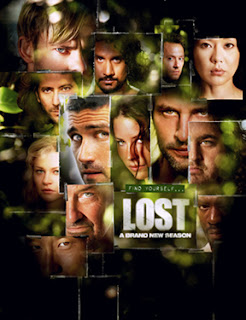.jpg)
LOST
Season 3 Episodes 22 & 23
(WARNING: SPOILERS)
“Through the Looking Glass” 1 & 2
Gentlemen, I asked you to dazzle me after enduring “Stranger in a Strange Land.”
Well, I’m officially blinded.
That has to go down as not just the best Lost season finale thus far, but also one of the most kick-a$$ season finales in all of TV history. When they said that this finale would change everything, that wasn’t just hyperbole.
I could go on about the twisty-turns of the episode itself (and it had that in spades), but the ultimate twisty-turn is that brilliant climax, of Jack, by the airport, as Kate drives away, because “he” might be wondering where she’s gone to.
Once again, Lost deftly toys with the show’s story structure, as what we assume to be the flashbacks (of a depressed and suicidal Jack hooked on prescription meds), turn out to be the present, and all the Island stuff is actually the flashbacks.
I said there were spoilers, didn’t I?
So it seems as if the Flight 815 crash survivors were indeed saved and rescued from the Island (at the cost of Charlie, who drowned in the Looking Glass station, just as Des saw in his flashes*).
Just before the off-screen rescue though, three crucial points:
1) Ben says that Naomi is “one of the bad guys,” and that she’s part of a group that’s been looking for the Island for a really long time, and that they would kill Jack and the survivors, not rescue them.
2) When Charlie gets the transmission from Penny at the Looking Glass, she does not know who Naomi is, and has no idea about any boat.
3) Locke actually kills Naomi and threatens to shoot Jack, since contacting Naomi’s people is the wrong thing to do.
And then of course, in the “flashbacks,” Jack is clearly a lost soul, and in his clandestine meeting with Kate, he says they should never have left the Island, and that they need to go back.
This is such a crackerjack finale, “brilliant” seems like an understatement. That ultimate twisty-turn opens the door to a whole host of possibilities, and raises all sorts of questions. (My head is doing a Linda Blair even as I type this.)
Whose viewing did Jack attend? A viewing apparently no one else from 815 went to. Locke’s? Michael’s? (Yes, I still hate the a$$hole’s guts.) Ben’s?
What happened to all the rest of the 815ers? Is Jack the only one who feels something is wrong, or are some of the others “lost” as well? (Heh. “Others.” “Lost.”)
Rousseau said she would stay on the Island since that was where she belonged. Is she still there? Is Alex? Is Locke? (If he wasn’t the one in that casket.)
As Jack suffers, where is Juliet? They did do the kissy-face back on the Island, so where is she in Jack’s time of need?
And did Kate really end up with Sawyer?
So many questions…
And of course, the other reality here is, Lindelof, Cuse, and company have again (for the time being) managed to evade addressing long-standing Island questions, among them one from all the way back to the Pilot (What is the Monster Alternately Known As Smokey?), to ones of more recent mint (Who is Jacob?), to the Mother of all Lost questions (What is the Island?**).
Having said that though, I cannot deny the guts it took to make that leap. I also cannot deny the skill with which that leap was made.
That was explosive television, gentlemen. The storytelling on this show continues to be some of the best on the cathode ray horizon, and as Carrie Fisher said over On The Lot, “My hat, wherever it is, is off to you.”
And thanks for not having Sun die horribly in labor on the Island. (Of course, for all I know, she and her baby have been abducted by Dharma or some other mysterious organization to undergo insidious tests. Her baby, after all, is the first child to have been conceived on the Island in what I guess is a very long time, assuming of course that the baby is alive and well.)
Speaking of babies, when exactly will Jack find out that Claire is his half-sister and that Aaron is his half-nephew? I mean, wasn’t that bit of info in the files the Others had on the 815ers? Didn’t Juliet read that? Surely Ben did.
Let’s just toss that on the massive pile of Lost questions, shall we?
I’ll admit it: I love this show, but it’s the biggest tease on television.
Onward ho! Season 4!
* Incredibly moving, but couldn’t Charlie have squeezed through that porthole, once the room was filled with water? And did he really need to shut the door in the first place?
** I’ve got a theory which grew over the course of season 3, and burst into my consciousness as I watched the 2-hour finale. But somehow I’d still feel like a raving lunatic if I voiced it here.
Tell you what. When Lost finally does that reveal, I’ll admit whether I was right or wrong.
COUNTDOWN: 48.
COUNTDOWN TO RESUME IN 2008.
THE DHARMA INITIATIVE NEEDS YOU.
(Season 3 promotional image courtesy of atnzone.com.)
Season 3 Episodes 22 & 23
(WARNING: SPOILERS)
“Through the Looking Glass” 1 & 2
Gentlemen, I asked you to dazzle me after enduring “Stranger in a Strange Land.”
Well, I’m officially blinded.
That has to go down as not just the best Lost season finale thus far, but also one of the most kick-a$$ season finales in all of TV history. When they said that this finale would change everything, that wasn’t just hyperbole.
I could go on about the twisty-turns of the episode itself (and it had that in spades), but the ultimate twisty-turn is that brilliant climax, of Jack, by the airport, as Kate drives away, because “he” might be wondering where she’s gone to.
Once again, Lost deftly toys with the show’s story structure, as what we assume to be the flashbacks (of a depressed and suicidal Jack hooked on prescription meds), turn out to be the present, and all the Island stuff is actually the flashbacks.
I said there were spoilers, didn’t I?
So it seems as if the Flight 815 crash survivors were indeed saved and rescued from the Island (at the cost of Charlie, who drowned in the Looking Glass station, just as Des saw in his flashes*).
Just before the off-screen rescue though, three crucial points:
1) Ben says that Naomi is “one of the bad guys,” and that she’s part of a group that’s been looking for the Island for a really long time, and that they would kill Jack and the survivors, not rescue them.
2) When Charlie gets the transmission from Penny at the Looking Glass, she does not know who Naomi is, and has no idea about any boat.
3) Locke actually kills Naomi and threatens to shoot Jack, since contacting Naomi’s people is the wrong thing to do.
And then of course, in the “flashbacks,” Jack is clearly a lost soul, and in his clandestine meeting with Kate, he says they should never have left the Island, and that they need to go back.
This is such a crackerjack finale, “brilliant” seems like an understatement. That ultimate twisty-turn opens the door to a whole host of possibilities, and raises all sorts of questions. (My head is doing a Linda Blair even as I type this.)
Whose viewing did Jack attend? A viewing apparently no one else from 815 went to. Locke’s? Michael’s? (Yes, I still hate the a$$hole’s guts.) Ben’s?
What happened to all the rest of the 815ers? Is Jack the only one who feels something is wrong, or are some of the others “lost” as well? (Heh. “Others.” “Lost.”)
Rousseau said she would stay on the Island since that was where she belonged. Is she still there? Is Alex? Is Locke? (If he wasn’t the one in that casket.)
As Jack suffers, where is Juliet? They did do the kissy-face back on the Island, so where is she in Jack’s time of need?
And did Kate really end up with Sawyer?
So many questions…
And of course, the other reality here is, Lindelof, Cuse, and company have again (for the time being) managed to evade addressing long-standing Island questions, among them one from all the way back to the Pilot (What is the Monster Alternately Known As Smokey?), to ones of more recent mint (Who is Jacob?), to the Mother of all Lost questions (What is the Island?**).
Having said that though, I cannot deny the guts it took to make that leap. I also cannot deny the skill with which that leap was made.
That was explosive television, gentlemen. The storytelling on this show continues to be some of the best on the cathode ray horizon, and as Carrie Fisher said over On The Lot, “My hat, wherever it is, is off to you.”
And thanks for not having Sun die horribly in labor on the Island. (Of course, for all I know, she and her baby have been abducted by Dharma or some other mysterious organization to undergo insidious tests. Her baby, after all, is the first child to have been conceived on the Island in what I guess is a very long time, assuming of course that the baby is alive and well.)
Speaking of babies, when exactly will Jack find out that Claire is his half-sister and that Aaron is his half-nephew? I mean, wasn’t that bit of info in the files the Others had on the 815ers? Didn’t Juliet read that? Surely Ben did.
Let’s just toss that on the massive pile of Lost questions, shall we?
I’ll admit it: I love this show, but it’s the biggest tease on television.
Onward ho! Season 4!
* Incredibly moving, but couldn’t Charlie have squeezed through that porthole, once the room was filled with water? And did he really need to shut the door in the first place?
** I’ve got a theory which grew over the course of season 3, and burst into my consciousness as I watched the 2-hour finale. But somehow I’d still feel like a raving lunatic if I voiced it here.
Tell you what. When Lost finally does that reveal, I’ll admit whether I was right or wrong.
COUNTDOWN: 48.
COUNTDOWN TO RESUME IN 2008.
THE DHARMA INITIATIVE NEEDS YOU.
(Season 3 promotional image courtesy of atnzone.com.)







.jpg)
+blog.jpg)
.jpg)
.jpg)
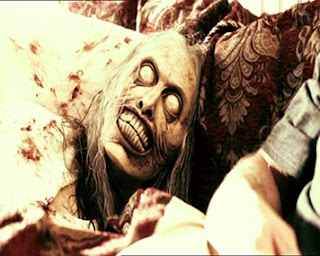

.jpg)
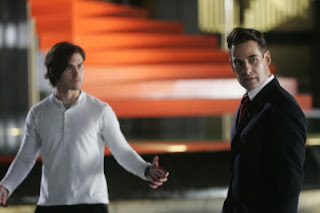

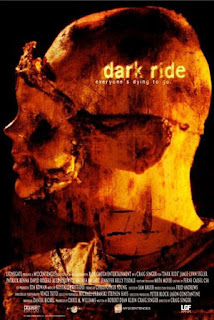.jpg)


+blog.jpg)
+2.jpg)
.jpg)
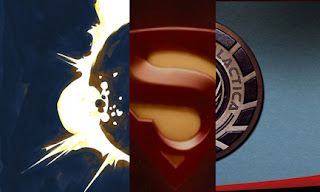


.jpg)